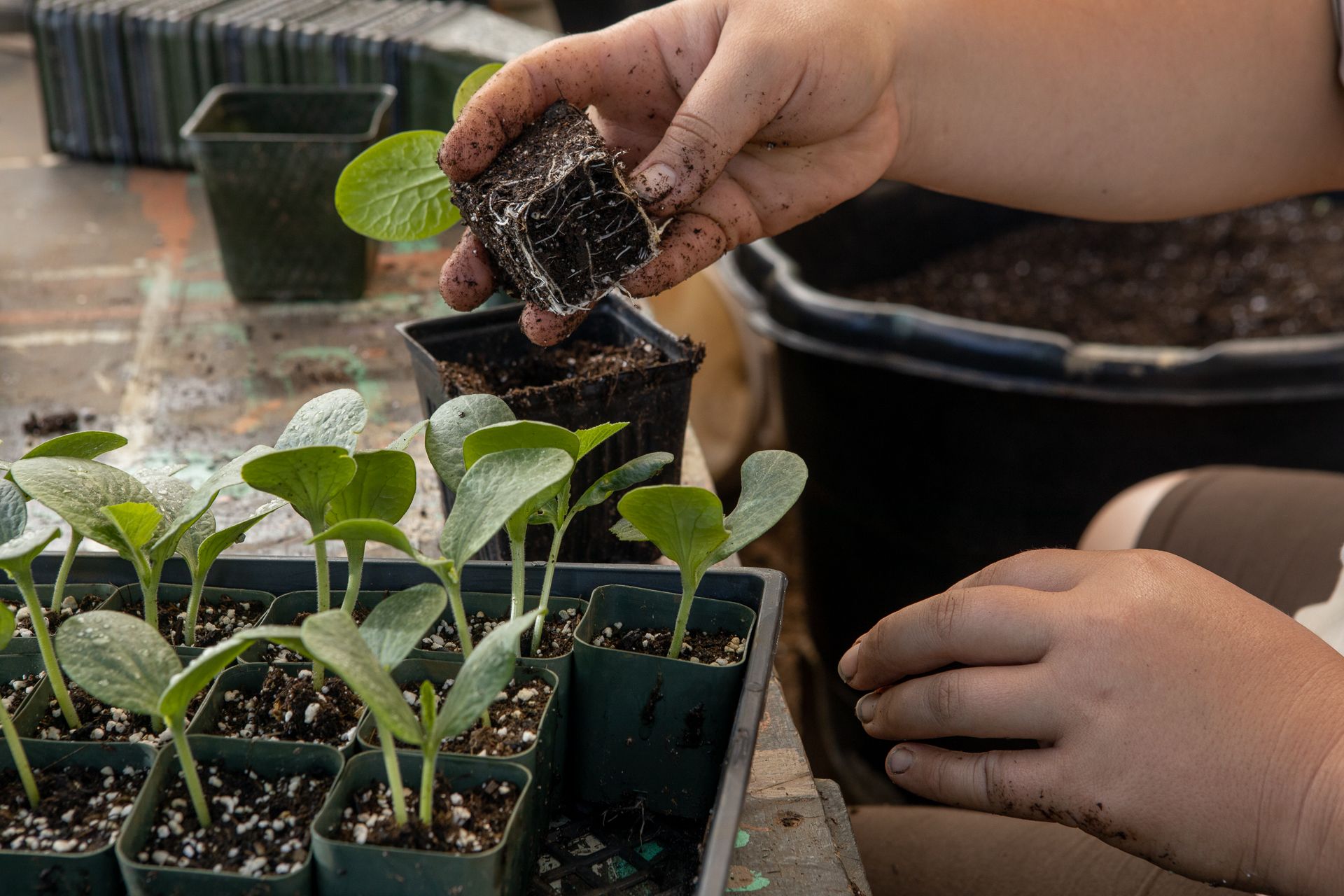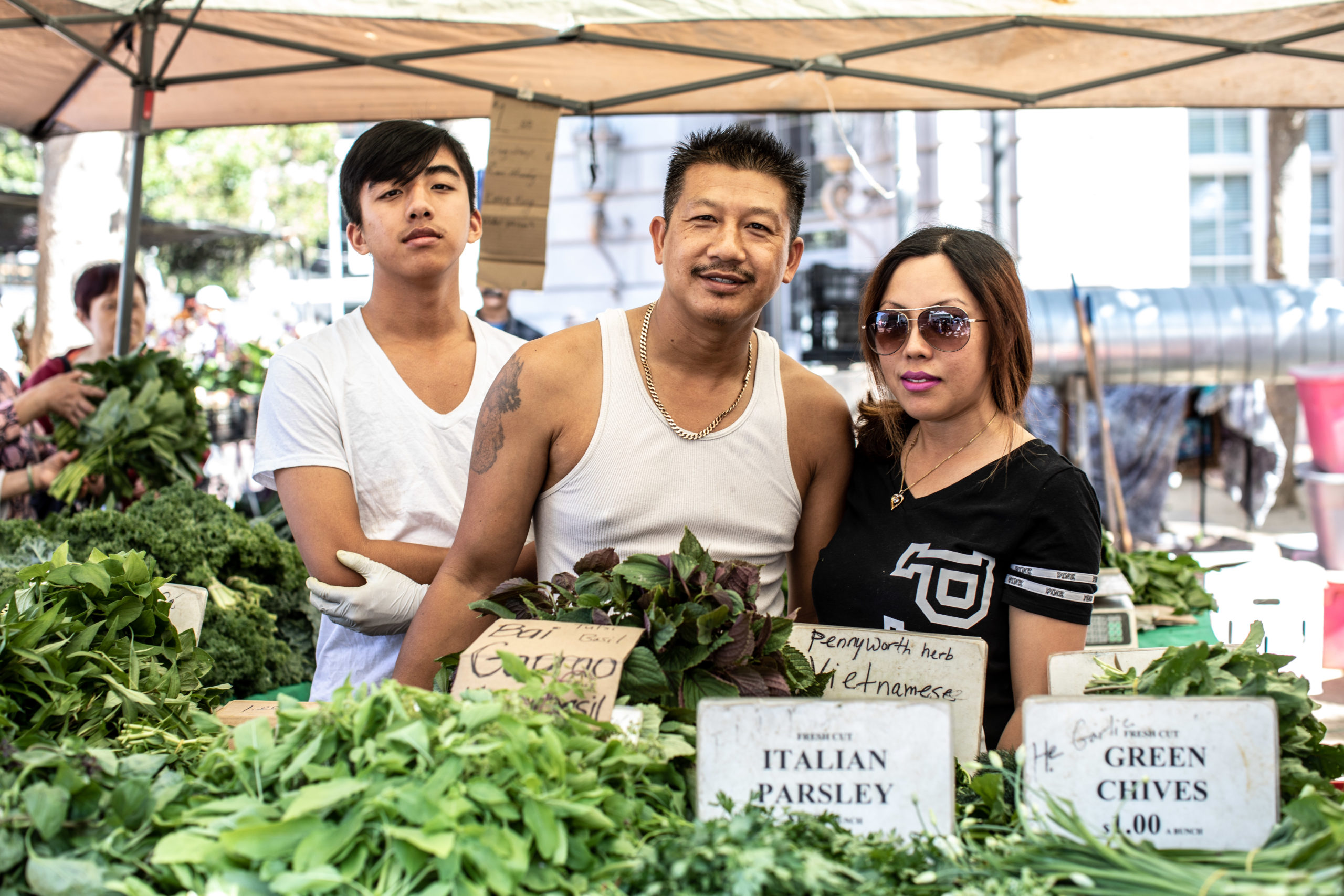“Heal, Resist, Grow”
Panel Discussion With VietLead Resilient Roots Community Farm Leaders

My curiosities around how community members of the Asian diaspora are defining, making meaning out of, and joining the food justice movement came from the Asian and Pacific Islander (API) Council’s 2021 “Food Justice in Turbulent Times” report that explored the needs and challenges of food justice at the intersection of racialization, racial justice, cultural preservation, and economic justice. Some of the report’s findings include the need for systems-level transformation and cross-sector interventions, as well as the systemic racial inequities that our food system creates for Asian and Pacific Islander communities.
For Asian Americans, this can be seen in the systemic barriers to accessing land—and, consequently, food—that is healthy, accessible, and affirming to cultural foodways.

Civil Eats (2019)
“The United States Census of Agriculture shows that Asian Americans made up less than 1 percent of the farming population in the United States in 2017. More than 95 percent of the full-time operators in the U.S. are white.” That can be attributed to racist laws and policies, such as the Chinese Exclusion Act of 1882, California Alien Land Law, and Japanese incarceration camps that systematically denied Asians farmland.” (NBC News, 2019)
“Access to land is the number one barrier for people of color to feed our communities healthy, fresh food. Dispossession and theft of land and labor from Indigenous nations and Black folks built the foundation of the United States, cutting us off from health, wealth, language, knowledge, and sense of place. What farmland is still left is threatened by agricultural runoff from commodity farms, nutrient depletion, shrinking biodiversity, and skyrocketing prices, all symptoms of late stage capitalism and settler colonialism.” (Northeast Farmers of Color Land Trust)
“White landowners currently control between 95-98% of the farmland in the United States and receive over 97% of agriculture-related financial assistance. The 2018 Farm Bill, like its policy predecessors, set aside hundreds of millions in commodity subsidies for technology, genetic manipulation, corporatized plant, and animal varieties, and flow into international markets.” (Northeast Farmers of Color Land Trust)
Because of the findings in API Council’s report, as well as these findings around systemic barriers for Asian American communities at the intersection of food and land, I wanted to learn more about the ways that Asian and Asian American folks in farming and land stewardship are centering community power and enacting food justice work in transformative ways.
How are individuals in the Asian diaspora defining and joining in the work of food justice and food sovereignty? What are some of the needs and calls to action of those who are working on the ground for food justice? What do they see as sustainable solutions to the challenges they are facing as they build out their visions of food justice in solidarity with other marginalized communities?
Those questions guided my process and the queries I posed to interviewees.
I came into this project curious and hoping to build out food justice understandings from the narratives of some food justice practitioners of the Asian diaspora. My interviewees are primarily of the East Asian and Southeast Asian diaspora, so this project is a small snapshot of a vast community. This project can reveal the utility of the coalition of the Asian diaspora and the political formation that is Asian America, as well as the shortcomings of these racial groupings and the erasure that may occur.

Hello! My name is Megan Duong. I am a Food Security intern at Stupski Foundation. I would like to thank the staff and interns at Stupski and everyone who has supported this process. Thank you to all of the individuals who shared their narratives in this project—for their powerful stories, reflections, candidness, and deep wisdom and all of the work they are doing on the ground to build toward food and land justice.
How has the work that you and the Student Farm do around food justice transformed your relationships—whether to the land, your community, your family, food, the system, your history, or other relationships?
Through your work, what do you see as your community’s stake in food justice, and/or what do you see as the Asian diaspora’s stake(s) in food justice? How are you defining food justice for your community? (You can define community however you would like.)
What are some policies in food justice that are exciting to you, or what do you want to see changed in the system? What systems change do you hope to see to make your work even more infinite or so that there is less of a need for the work your organization is doing?
Through your experiences, what do you see as your role and/or Asian Americans’ role in solidarity with and in alignment with what food justice means to Black, Indigenous, and other people of color? What does that look like in practice? What other forms of solidarity do you see emerging from your work?
What is your organization’s relationship to funders and funding? What would you want to change about it? What would you want to tell funders?
Whom do you collaborate with? Who are the people you look to for inspiration and direction in the work that you do?

“And `{`we’re`}` actually growing a new method for farming. Farming that isn’t just a land owner and a farm manager, who’s just ordering people around, and everyone else is underpaid and not respected and doesn’t have a say. We’re actually trying to collectively manage the farm and build our youth up and build our elders up so that there is a collective sense of ownership over this space. And I think that’s where we’re seeing systems change at least with food sovereignty.”
“You’re like, ‘oh, well, if I just feel how important this is, I can’t think about dispossessing anybody of their land.’ Like it makes me think differently about living in this sort of settler context differently. And I think we feel like so many community members are so much more accountable and cognizant of things like climate change, because now they have a relationship with a farm.”
“I know that in Camden specifically they don’t have a lot of food access. And people usually have a hard time to find the place to buy vegetables, to buy food, because it’s kind of limited and people that can’t afford it, they don’t find a good place to buy the food.”
“Food justice is the ability for people to know where their food came from, how it is produced, transportation. Last year we did a survey to ask about weekly bags for people who do not have the ability to access fresh food. Majority of them don’t know the government provides food stamps. They can’t understand what it means and what benefits it provides for them. They came from another country, and vegetables are expensive.”
“The types of resources that I think it’s going to take to adequately address some of the issues in terms of just seed and biodiversity—there’s so many gaps in terms of having things that really are going to drive true resilience for different communities of color in terms of their food security and also farmers of color, particularly their economic viability.”
“And I know that generally we sort of rely on each other in this community for resources, just because a lot of the times the other corporations have such a chokehold on Westernized crops that we are trying to make sure that we are able to provide Asian American and Pacific Islander farmers with these types of resources.”
“But it was also the first time that I felt a little inkling of connecting to being Korean, because in 2002, there was a Korean farmer who killed himself at the WTO `{`World Trade Organization`}` meeting in Cancun to just say that the WTO is killing farmers. I had been hanging out with all these people and a lot of people from Chiapas and Mexico working on Indigenous food sovereignty. And then to have a Korean farmer do that, when I had not thought or really considered what was happening that mirrored parts of Central America in Asia.”
“I think ultimately it was about building solidarity with one another on land. Because a lot of our neighbors and other growers at the farm aren’t just Vietnamese people. They’re also other immigrant folks or Black folks who migrated `{`from the`}` South up to this region and have background in farming. There’s like a way for folks to be like, ‘Yeah, this is home.’ Our histories go way back, you know?”
“I didn’t recognize that a lot of the culture that I have in the past deals with land and agriculture, and being able to be a part of that, being able to essentially breed life, in a sense, has been super amazing to me as well.”
“She was a neighbor, and at the time she was battling diabetes. And so she started coming out to the farm to find her home. Now she feels a lot healthier and better and more active. And eventually, now she feels a lot better about her health.”
“So while we bring a lot of students out to learn about how to grow and in an urban environment, we also need to figure out how to like re-enchant people with the process of growing. So that people can ask things like, ‘Wow, how does this plant produce fruit or flower?’ So kind of creating opportunities for people to get curious again.”
“But I think what was transformative about that was actually the lessons you learn, and seeing natural farming, and then learning from farmers in Korea. It flips all of that on its head, the notion and mythology of self-reliance and self-sufficiency.”
What do these stories and lessons mean for food justice movements in the Bay Area and Hawai‘i, as well as for the future of philanthropy?
To build toward our collective food justice dreams, these leaders made clear calls to action.
Kristyn:
“I just think there needs to be mechanisms to value the contributions that farmers make to that soil. For me, the biggest push is just people figuring out how to actually transfer land permanently into farmer’s hands and just the types of mechanisms that can be in place to ensure that it keeps being farmed and keeps being accessible as farmland.”
Thao:
“Some things that feel exciting are redirecting resources to fund land-based projects and community-led land-based projects specifically. So not just huge amounts of federal funding going to federal-backed NGOs [nongovernmental organizations] or whatever. But rather like resources for community-led projects, grassroots-led projects, of folks reclaiming gardening sites in their cities or on the sidewalks, and having community land trusts. So how do we really uplift people’s capacity to acquire land and to steward land?”
Kristyn:
“We had written a research grant to do more breeding of Asian vegetables through their organics program, and we just got denied it yesterday. And I think it’s just to say I’m curious more if private foundations can help fill some of these gaps in terms of just how demoralizing it felt to write a grant to an agency that I think is managed through the government or USDA [U.S. Department of Agriculture]. If the government obviously has no real interest in any sort of equity and inclusion, like how do other sources of funding for this type of research?”
An:
“Attaching your cultural foods to negative ideas of health is something that’s been pretty horrible, too. It’s just another idea of Westernizing the types of foods that you have in order to promote eating Westernized foods, eating Westernized products and produce. We need to see that a lot of the corporations that are at play do this sort of marketing and messaging towards us to think that way.”
Kristyn:
“But it’s just in trying to rebuild that. And I think piece together, like restoring a narrative for people that just sees like all of this wisdom, these healthy lifestyles and things is something that should have been a birthright.”
An:
“I do transcribing for interviews for these food bank leaders. And that’s a thing that pops up a lot. They’re always talking about, ‘We need to target poverty in order to eliminate food insecurity.’ I mean that’s the age-old problem, like we’re trying to eliminate poverty, and that goes back to capitalism.”
Kristyn:
“You just realize how much food and the sort of global food chain—it’s got its handprint in everything. So many of the wars that have been fought, different types of military activities around the world. Food is really central, even if it’s not what’s being talked about.”
Thao:
“Certain work, especially nonprofit work, gets elevated above others. And so we think that land access and environmental justice and land justice work are pretty endemically underfunded because that’s one of the ways that the US government and also other corporate entities are able to maintain control over land—to deny us access to it.”
Thao:
“It’s always great to have funding that isn’t so tied up with foundation interest. As part of the nonprofit industrial complex, it’s really easy for granters to have a lot of power in the relationship and to kind of direct where and how money is spent. And I think that money that isn’t tied up with requirements is always really great. And also sustained support that isn’t conditional. We can’t really build out a community and sustain our people long term if we know that it’s just gonna vanish. We definitely want to find more funders who are willing to commit to a community long term and not just look at numbers or how much were we able to do or produce, but rather how deep have we been able to grow. And maybe really understand the ecology of the communities that they’re supporting. And spend more time with us! Come to be within the communities that are being funded. To understand that it’s not just about the funding, it’s actually the work. The funding is a huge part of it—to be able to receive the resources. But the people is what activates it; it’s how anything gets done.”
Learn more about the themes in my project from the resources below.